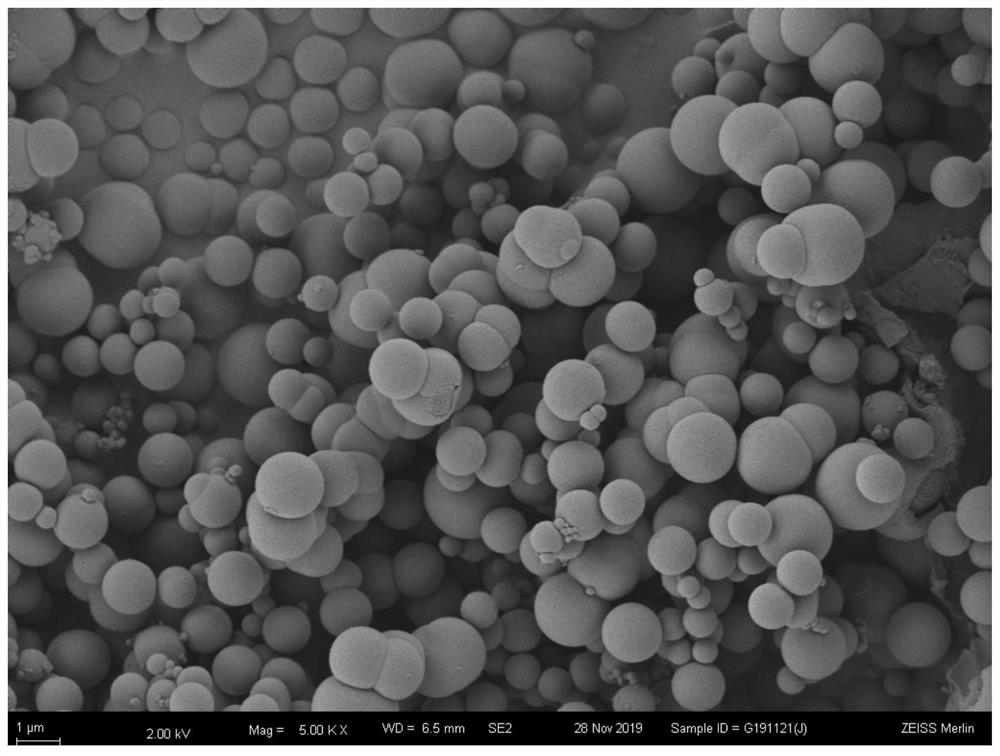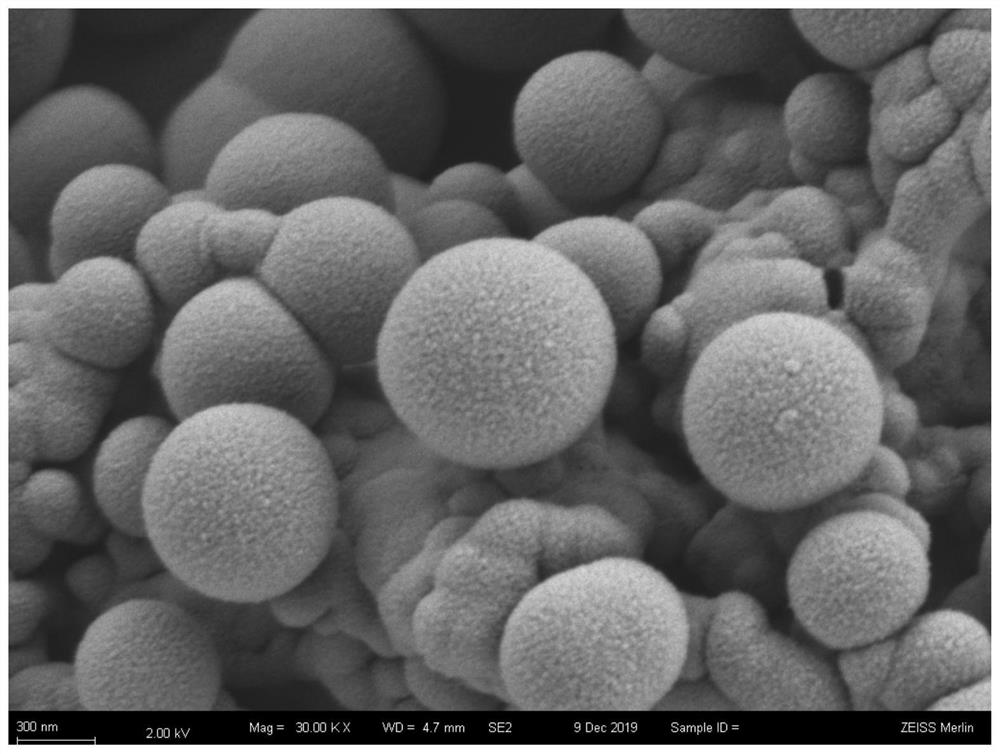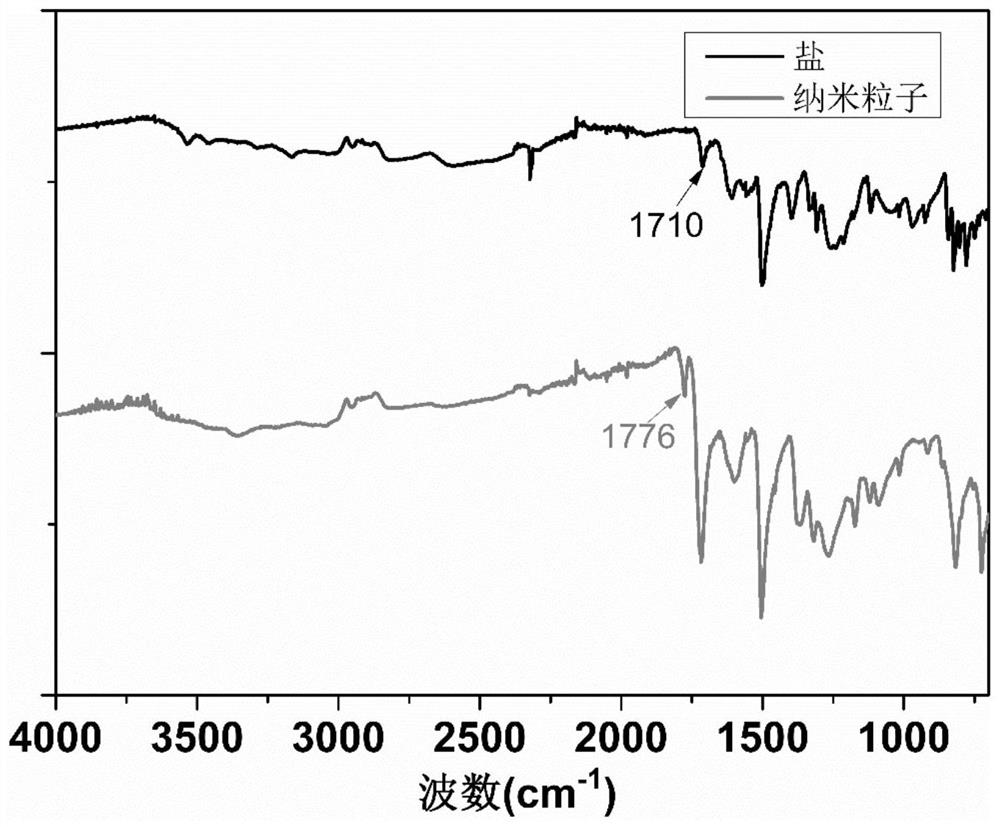Polyimide nano particle as well as preparation method and application thereof
A technology of polyimide and nanoparticles, applied in textiles and papermaking, single-component synthetic polymer rayon, fiber chemical characteristics, etc., can solve problems such as insufficient compatibility
- Summary
- Abstract
- Description
- Claims
- Application Information
AI Technical Summary
Problems solved by technology
Method used
Image
Examples
Embodiment 1
[0077] 1. The 2.00g homophthalic anhydride (9.16mmol) was dispersed into 98.00g of water, and the heating solution temperature was stirred to 80 °C for 2h until the monomer was completely dissolved, at which time the solution was given an aqueous solution of homophthalic acid.
[0078] 2. 1.51g tri(4-aminophenyl)amine (5.19mmol) and 0.21g 3,5-diaminobenzoic acid (1.38mmol) dissolved in water, to be dissolved and dispersed, slowly added to the homophenylenetetracarboxylic acid solution to form a salt, stirred to obtain a powder solid, select ethanol solvent for cleaning and filtration, vacuum drying to obtain a salt monomer composed of acid and amine composite.
[0079] 3. Disperse 1.00g of salt into 99.00g of water, then transfer it to a hydrothermal reactor with stirring, set the reaction temperature to 180 °C, stirring the reaction for 6h.
[0080]4. The product is dispersed into water / ethanol solution for cleaning, filtering, and gradually replacing the water / ethanol solution ...
Embodiment 2
[0084] 1. As in Step 1 of Example 1, a homophthalic acid solution is obtained.
[0085] 2. 0.68g of 1,3,5,7-tetraaminoadamantane (3.44mmol) and 0.35g of 3,5-diaminobenzoic acid (2.29mmol) dispersed in ethanol solution, to be dissolved and dispersed, slowly added to the homophthalic acid solution to form a salt, stirred to obtain a powder solid, select an ethanol solvent for cleaning and filtration, vacuum drying to obtain a salt monomer composed of acid and amine compound.
[0086] 3. Perform a hydrothermal reaction as in step 3 of Example 1.
[0087] 4. As in step 4 of Example 1, the sample is cleaned and dried, and the spherical nanoparticles with a size distribution of 0.1~ 0.5 μm are obtained by electron microscopy, such as Figure 2 as shown.
[0088] 5. As in step 5 of Example 1, the blend coating film is carried out, and a polyimide composite film is prepared.
[0089] 6. After the polyimide composite film is modified, the surface wettability is improved, the contact angle o...
Embodiment 3
[0091] 1.00g of homophthalicarboxylic dianhydride (4.58mmol) and 1.35g of 3,3,4,4-biphenyltetracarboxylic dianhydride (4.58mmol) dispersed into 97.65g of water, heated solution temperature to 80 °C stirred for 4h reaction, added 10g ethanol, so that the two tetraic acid monomers completely dissolved in solution.
[0092] 2. 1.51g tri(4-aminophenyl)amine (5.19mmol) and 0.21g 3,5-diaminobenzoic acid (1.38mmol) dissolved in water, to be dissolved and dispersed, slowly added to the homophenylenetetracarboxylic acid solution to form a salt, stirred to obtain a powder solid, select ethanol solvent for cleaning and filtration, vacuum drying to obtain a salt monomer composed of acid and amine composite.
[0093] 3. Perform a hydrothermal reaction as in step 3 of Example 1.
[0094] 4. As in step 4 of Example 1, the sample is cleaned and dried, and the spherical nanoparticles with a size distribution of 2 to 4 μm are obtained by electron microscopy characterization statistics.
[0095] 5. Th...
PUM
| Property | Measurement | Unit |
|---|---|---|
| particle diameter | aaaaa | aaaaa |
| size | aaaaa | aaaaa |
| tensile strength | aaaaa | aaaaa |
Abstract
Description
Claims
Application Information
 Login to View More
Login to View More - R&D Engineer
- R&D Manager
- IP Professional
- Industry Leading Data Capabilities
- Powerful AI technology
- Patent DNA Extraction
Browse by: Latest US Patents, China's latest patents, Technical Efficacy Thesaurus, Application Domain, Technology Topic, Popular Technical Reports.
© 2024 PatSnap. All rights reserved.Legal|Privacy policy|Modern Slavery Act Transparency Statement|Sitemap|About US| Contact US: help@patsnap.com










